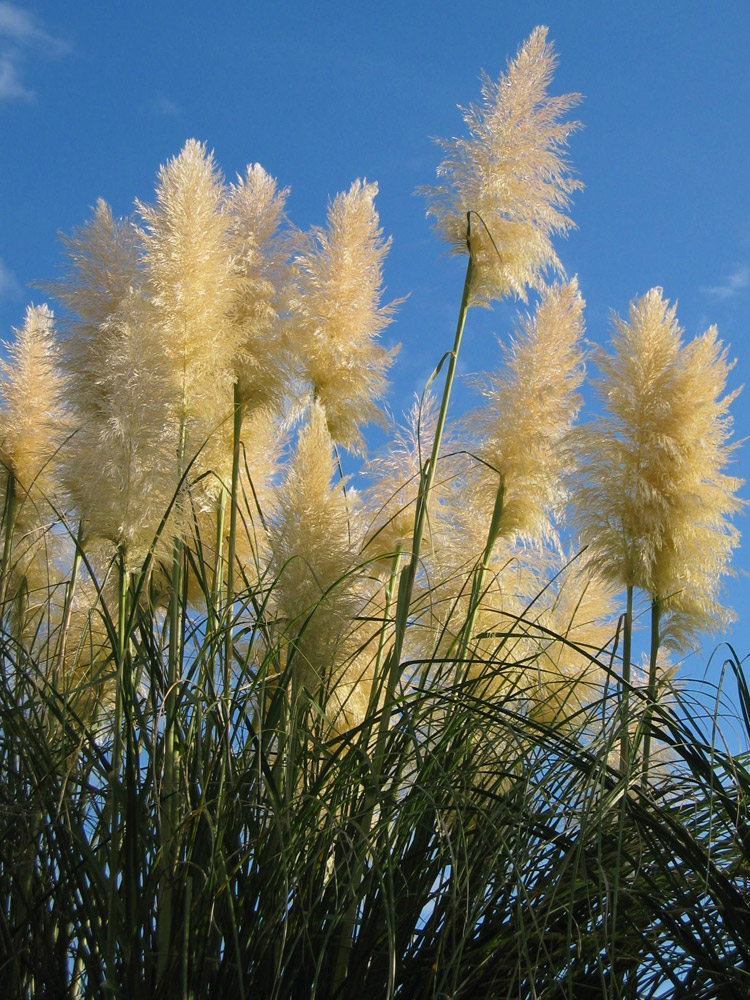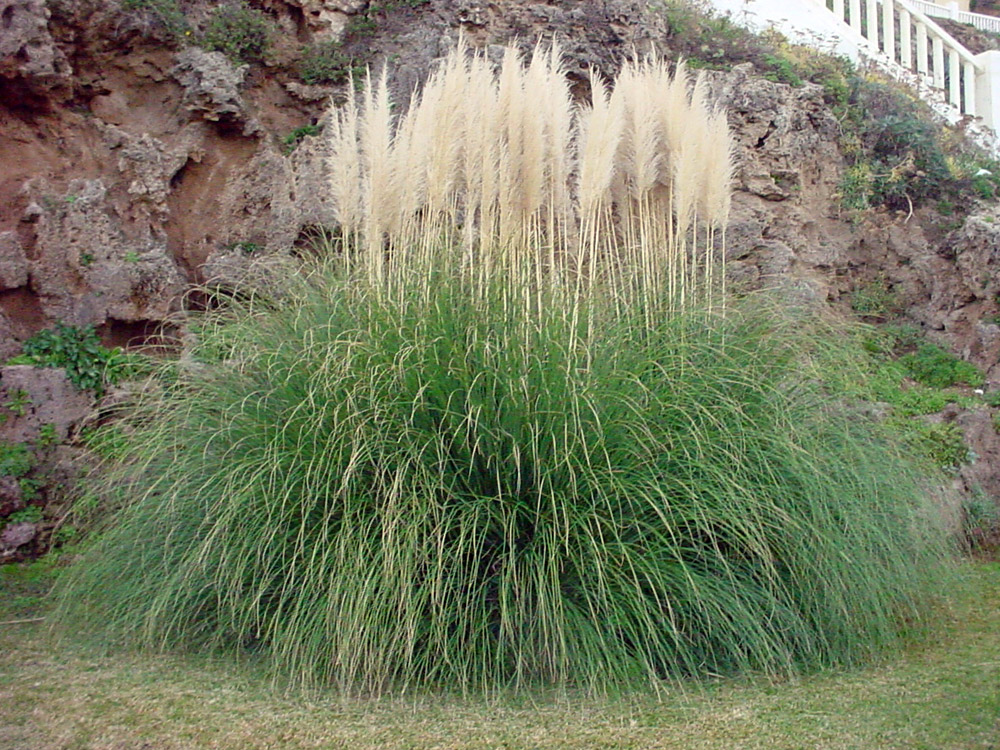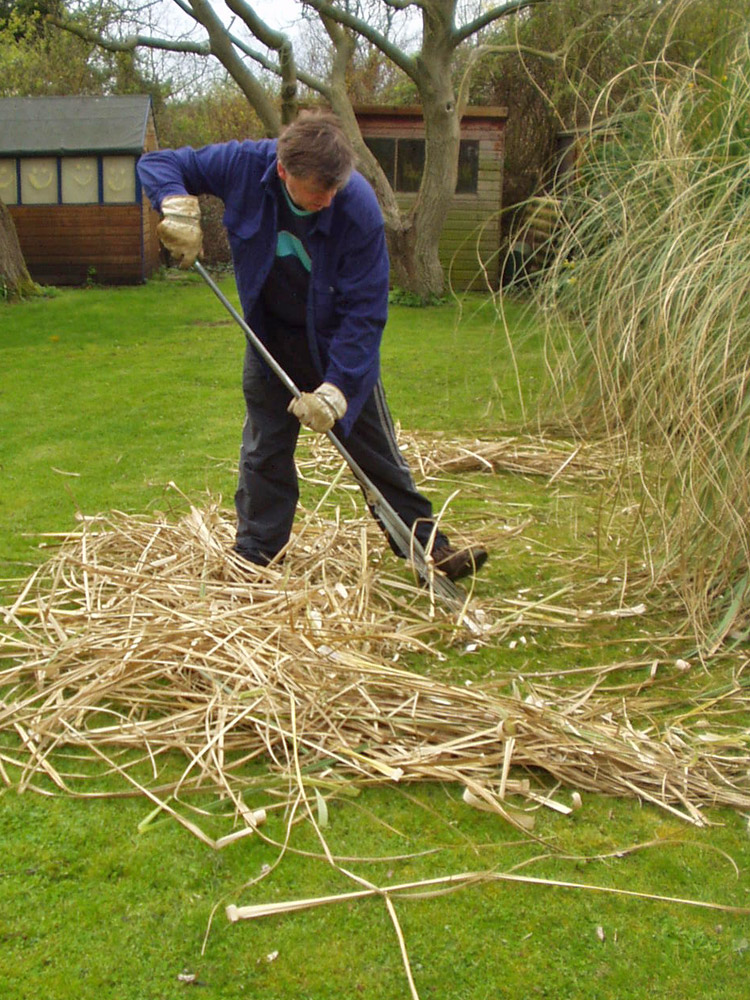Garden Plants, How and where to grow them
Grasses
Pampas Grass
Cortaderia selloana - Grass
Hardy reliable, strong growing with magnificent seed heads, poor old pampas grass has had a bit of a bad press.
Buy Pampas Grass - Cortaderia selloana - Grass
 Like some other plants Pampas grass has earned its reputation
unfairly and largely as a result of being planted inappropriately.
It is a big plant, 6ft tall by about the same wide, with flower
panicles (those great tall seed head things) to 10ft or so.
Plant it slap bang in the middle of a small lawn and it will
look completely overwhelming, maybe people thought "oh
its only a grass, it can't get that big".
Like some other plants Pampas grass has earned its reputation
unfairly and largely as a result of being planted inappropriately.
It is a big plant, 6ft tall by about the same wide, with flower
panicles (those great tall seed head things) to 10ft or so.
Plant it slap bang in the middle of a small lawn and it will
look completely overwhelming, maybe people thought "oh
its only a grass, it can't get that big".
Best planted at the margins of a garden or at the back of a mixed border unless you have great expanses of lawn. If you can, plant it so that the sun sets behind it when viewed from your house or usual garden viewing place and you could well come to love it. It's very resilient and an easy plant to grow, try it in a difficult area where its natural vigour may well allow it to thrive while the difficult conditions will keep it smaller than normal size (but with fewer flower panicles).
The common type has traditional pale gold coloured seed heads, but now there's another variety "Rosea" with pink-flushed seed heads. The seed heads can be harvested once they've formed and opened fully, though I tend to leave mine until later in the winter when I don't go out so much and enjoy them on the plant before bringing them indoors. They form long lasting imposing decorations as part of some other kind of display or on their own and don't drop the seeds once harvested as long as you leave them for at least a month after they've opened properly.
Be careful where you place pampas grass plants, particularly if you have children, and also when trimming it. The leaves look soft and harmless, but they have very sharp backwards pointing tiny saw teeth along their edges. Always wear gloves and long sleeves when cutting it back.
There's also a rumour that has reached my ears that having a Pampas grass in your front garden was a sign that you were a "swinger", car keys in the fruit bowl and that sort of thing - oooh err missus!
- Height and spread: 3m x 2m (10ft x 6ft) (leaves to 2m / 6 feet, seed heads to the rest) Also a dwarf version available about 1/2 to 2/3rds the size of the standard types
- Position: full sun
- Soil: well-drained
- Rate of growth: average
- Flowering period: August to September
- Flower colour: silvery white / pink
- Other features: dense tussocks of grass-like leaves and fluffy white plumes that will last most of the winter if left in place. Reach as deep into the plant as you can and pull them out the next spring or sooner if they are felled by winter weather.
- Hardiness: fully hardy
- Uses: Specimen / mixed border
- Garden care: After a few
years old plants will start to build up a skirt of dead
leaves which makes them look tatty, they'll appear much
fresher and brighter when these are all removed. Do it in
late winter and before the bird breeding season as small
birds sometimes find the dense protective leaves an ideal
place to nest. I use a metal lawn rake with flexible tines
to reach under the plants and pull the dead leaves out,
be quite vigorous in this, you'll get a lot of leaves
from an average plant. Make sure you wear stout leather
gardening gloves so the leaves don't cut your hands
as they can easily do (sort of heavy-duty paper cuts), long
sleeves are also necessary, and also be careful not to get
poked in the eye by a leaf end from the parent plant or
from the long and stiff leaves you remove. Silly as you
might feel, eye protection wouldn't go amiss.
Finally reach into the middle of the plant and pull out individual remains of the seed heads, you can pull out any stray dead leaves this way too. When you've done, mulch the bottom with garden compost if you have any and give a feed of a slow acting fertilizer such as Gromore or Blood, Fish and Bonemeal.
Questions about Pampas Grass - Cortaderia selloana
Q. I cut my pampas grass back and then ran the stalks and old blooms through a chopper. Making lots of dust etc. Then I became sick with what I thought was a cold. Now we think it is an allergy to the pampas grass dust. Have you heard of this?
A. I've not heard specifically
of anyone being affected in the way you state, but I can well
believe it. Ornamental grasses including Pampas grass can cause
a lot of misery to allergy sufferers, usually at flowering time
in the fall/autumn. The pollen will have the greatest concentration
of allergens, but the whole plant is likely to have lower-level
similar chemicals that are usually held safely in situ. Shredding
it and making so much dust will throw these allergens into the
air as it seems happens with you. You don't say if you are
prone to allergies, but even if you aren't the concentration
as fine dust may have just been overwhelming. I usually
burn (stand well back!) or directly compost pampas grass leaves.
Q. I have a pampas
grass and was led to believe that you had to cut it back after
flowering each year and burn the stump that's left.
Do you cut any back?
A. It's not necessary to do so
that often. It will be a few years for a newly planted grass
before it needs dealing with in this manner. If your grass is
in an isolated position (not like mine - up against a fence),
then burning is a quick, easy and effective way to get rid of
old growth. Choose a late winters day in January or February,
before any new growth has started and the birds have started
to nest. The grass should be dry and it is preferably done in
a light breeze, push some newspaper under the old yellowed leaves
to get it started, It will burn very fiercely
but briefly and the ashes will help to fertilise the coming
years growth.
Q. I have a Pampas Grass, it is four years old, leaves some 2m high and looks good. I am aware it needs trimming in girth. What is the best way to do this please. Work outside to inside or leave and totally replant in a few years time ?
A. At four years old, your plant sounds almost fully grown, it will do best if allowed to do what it wants i.e. without regular drastic cutting back, so allow it to do its own thing and see if you can live with that - it will be a healthier and happier plant for being allowed to do so. If you do decide to trim it, the best way is to work in from the outside, if you feel it's too large for its situation a dwarf variety is available if you decide to uproot and replant.
Q. When is the best time for planting pampas grass seeds? Is it best to sprout the seeds indoors over the winter for a more rapid growth rate the following year? I plan to use the plants for a barrier between my property and a heavily travelled roadway. It is to the west of my home so it should give us a nice view with the sunset.
A. Seeds are naturally sown when they are ripe, so this is the best time to sow them. Some will start to grow straight away, others will need a winter before they start. Sow them in a seed tray and place it in a sheltered part of the garden, a coldframe is ideal, transplant the seedlings when they are large enough to be safely handled, wait until around midsummer before discarding the seed tray as they may well germinate at very different times. Bear in mind that seeds will be of the basic species, if your plant is a particular named cultivar, it won't come true to type.
Q. I planted pampas grass seeds 2 yrs ago, they are now planted in the garden where they get full sun all day until late afternoon, they have not yet flowered could you tell me how long it will be before they flower?
A. It's more of a case of size than age. If the mound of leaves is about 4-5 feet high, they should start to flower. Having said that - 2 years is rather too young.
Q. Recent high winds have snapped 3 of the 8ft tall flowering heads leaving only 2 intact. Should we cut the damaged stalks at the point where they broke (about half way up) or closer to ground level?
A. I hold the broken stem below the break and pull upwards so it breaks at a point that the plant "decides". Suggest you wear gardening gloves and long-sleeves before you delve in.
Q. A family up the street just moved in he does not want the pampas grass that is in his yard they are about 3-4 feet tall he said I could have them my question is when is the best time to dig up and replant them in my yard with out any harm to the plants.
A. The best time is in the dormant season which is approximately between leaf-fall and Christmas. If this is not possible, move the plant with the maximum of soil around the root ball - dig out as large a root-ball as you can manage, and re-plant immediately if possible. If it's not the dormant season, then water it in well and make sure it is well watered - deeply - every few days, it's almost impossible to give amounts and frequency, this is where your green-fingers kick in! Prepare yourself for a big job as the ball of soil and roots you will get will be large to say the least, you'll probably need help to get it in/out of a wheelbarrow, and wear protective clothing, the leaves are sharp!
Buy Pampas Grass - Cortaderia selloana - Grass
Photo credits: (numbering left to right top to bottom) 1-Avenue - Creative Commons Attribution 3.0 Unported license. / 2-Hans Olav Lien - Creative Commons Attribution 3.0 Unported license. / 3-Paul Ward - angliangardener.co.uk
Copyright 2000 - present. All Rights Reserved | Privacy Policy Statement


